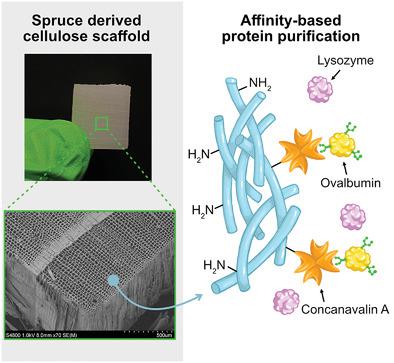当前位置:
X-MOL 学术
›
Adv. Mater. Interfaces
›
论文详情
Our official English website, www.x-mol.net, welcomes your feedback! (Note: you will need to create a separate account there.)
Surface Functionalization of Spruce-Derived Cellulose Scaffold for Glycoprotein Separation
Advanced Materials Interfaces ( IF 5.4 ) Pub Date : 2021-09-13 , DOI: 10.1002/admi.202100787 Kai Li 1, 2 , Shennan Wang 1 , Salla Koskela 1, 2 , Qi Zhou 1, 2
Advanced Materials Interfaces ( IF 5.4 ) Pub Date : 2021-09-13 , DOI: 10.1002/admi.202100787 Kai Li 1, 2 , Shennan Wang 1 , Salla Koskela 1, 2 , Qi Zhou 1, 2
Affiliation

|
Protein immobilization on a stationary phase, such as nanocelluloses, is widely used in biodiagnostic, biocatalytic, and bioseparation applications. With the top-down approach which utilizes the native hardwood honeycomb structure, mesoporous cellulose scaffolds can be fabricated without the need for energy-consuming production and bottom-up assembly of nanocelluloses. However, this approach is difficult for preparing softwood-based cellulose scaffolds due to the disintegration of wood cells after complete delignification. Herein, for the first time the use of spruce softwood with a homogenous cellular structure of longitudinally positioned and top-to-bottom joined tracheids is explored as a scaffold for protein immobilization. 1,4-butanediol diglycidyl ether is utilized to crosslink cell wall polysaccharides before the delignification step, thus improving the adhesion between tracheids. The native cellular structure of spruce is well preserved after the complete removal of lignin, enabling the successful production of a highly mesoporous and mechanically robust spruce-derived cellulose scaffold with exceptionally high specific surface area (219 m2 g−1). Further amination of the cellulose scaffold allows covalent immobilization of functional biomolecules, such as a lectin protein concanavalin A (Con A) and biotin, on the lumen surfaces and inside the porous cell wall. The Con A immobilized scaffold demonstrates native glycoprotein-binding activity and possible glycoprotein separation application.
中文翻译:

用于糖蛋白分离的云杉衍生纤维素支架的表面功能化
固定相(如纳米纤维素)上的蛋白质固定化广泛用于生物诊断、生物催化和生物分离应用。通过利用天然硬木蜂窝结构的自上而下的方法,可以制造介孔纤维素支架,而无需消耗能量的生产和纳米纤维素的自下而上组装。然而,由于木材细胞在完全脱木素后分解,这种方法难以制备软木基纤维素支架。在此,首次探索了使用具有纵向定位和自上而下连接的气胞的同质细胞结构的云杉软木作为蛋白质固定支架。在脱木素步骤之前,1,4-丁二醇二缩水甘油醚用于交联细胞壁多糖,从而提高管胞间的附着力。完全去除木质素后,云杉的天然细胞结构得到了很好的保留,从而能够成功生产出具有极高比表面积(219 m2克-1 )。纤维素支架的进一步胺化允许功能性生物分子,例如凝集素蛋白伴刀豆球蛋白 A (Con A) 和生物素,共价固定在管腔表面和多孔细胞壁内部。Con A 固定支架展示了天然糖蛋白结合活性和可能的糖蛋白分离应用。
更新日期:2021-10-08
中文翻译:

用于糖蛋白分离的云杉衍生纤维素支架的表面功能化
固定相(如纳米纤维素)上的蛋白质固定化广泛用于生物诊断、生物催化和生物分离应用。通过利用天然硬木蜂窝结构的自上而下的方法,可以制造介孔纤维素支架,而无需消耗能量的生产和纳米纤维素的自下而上组装。然而,由于木材细胞在完全脱木素后分解,这种方法难以制备软木基纤维素支架。在此,首次探索了使用具有纵向定位和自上而下连接的气胞的同质细胞结构的云杉软木作为蛋白质固定支架。在脱木素步骤之前,1,4-丁二醇二缩水甘油醚用于交联细胞壁多糖,从而提高管胞间的附着力。完全去除木质素后,云杉的天然细胞结构得到了很好的保留,从而能够成功生产出具有极高比表面积(219 m2克-1 )。纤维素支架的进一步胺化允许功能性生物分子,例如凝集素蛋白伴刀豆球蛋白 A (Con A) 和生物素,共价固定在管腔表面和多孔细胞壁内部。Con A 固定支架展示了天然糖蛋白结合活性和可能的糖蛋白分离应用。



























 京公网安备 11010802027423号
京公网安备 11010802027423号